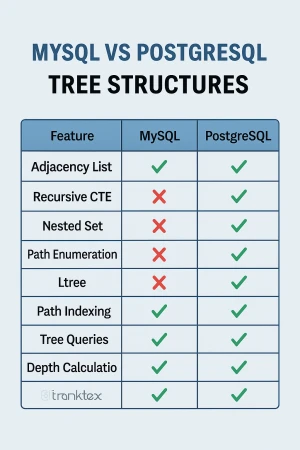الدورات
title
MySQL vs PostgreSQL — Full Comparison Focused on Tree Structures

Hierarchical (tree) data is common in modern systems, appearing in structures such as:
- Categories and subcategories
- Nested comments
- Organizational charts
- Chapters → Lessons → Topics
- Product attributes
- Folder → File systems
MySQL and PostgreSQL handle tree-based data very differently.
Below is a complete comparison.
1. Native Support for Hierarchical Data
PostgreSQL
PostgreSQL provides native, built-in support for hierarchical structures:
LTREE (built-in data type)
Allows storage of paths such as:
root.programming.php.laravel
This makes tree queries extremely fast and efficient.
Recursive CTE (WITH RECURSIVE)
Fully optimized, stable, and high-performance.
MySQL
- No native tree data type
- MySQL does not provide anything equivalent to LTREE
MySQL 8+ supports Recursive CTE, but:
- Performance is slower
- Optimizer is less mature
- Indexing is less effective
- Can hit recursion depth limits
Winner: PostgreSQL
PostgreSQL is designed with hierarchical data in mind.
2. Ways to Represent Tree Structures
Tree structures can be stored using several models.
Here is how each database handles them.
Model 1 — Adjacency List (parent_id)
FeaturePostgreSQLMySQLEasy to implementYesYesQuery childrenEasyEasyQuery ancestorsFast (recursive CTE)Slow (pre–MySQL 8)Query entire treeFastSlowerDepth calculationsRecursive CTERequires manual logic
PostgreSQL performs adjacency list queries much faster due to stronger recursive CTE support.
Model 2 — Nested Set / MPTT
FeaturePostgreSQLMySQLQuery full treeFastFastInsert / move nodesExpensiveExpensiveMaintaining left/right indexesHeavyHeavyIndex performanceStrongGood
Both databases behave similarly, but MySQL may lock tables more aggressively.
Model 3 — Path Enumeration (full path as string)
Example:
/root/programming/php/laravel
FeaturePostgreSQLMySQLString pathsYesYesIndexing pathsGiST/GiN indexesLimitedWildcard searchSupported via LTREE operatorsRequires LIKEQuery descendantsVery fast (path <@ 'x')Slow (LIKE 'x%')
PostgreSQL dominates due to LTREE and specialized indexes.
Model 4 — PostgreSQL LTREE (PostgreSQL only)
MySQL: Not available
PostgreSQL: Full support
Examples:
Ancestor queries
SELECT * FROM categories WHERE path @> 'lms.programming';
Descendant queries
SELECT * FROM categories WHERE path <@ 'lms.programming.php';
Pattern matching
SELECT * FROM categories WHERE path ~ '*.php';
MySQL cannot perform these queries natively.
3. Indexing Differences for Trees
PostgreSQL
Supports advanced index types:
- GiST
- GiN
- SP-GiST
These allow indexing tree paths efficiently.
MySQL
Supports:
- BTREE only
- Optional HASH (Memory engine only)
BTREE is not optimized for deep hierarchical data.
Winner: PostgreSQL
4. Querying Tree Data
PostgreSQL LTREE example
SELECT name FROM categories WHERE path <@ 'lms.programming';
Fast, indexed, and optimized.
PostgreSQL Recursive CTE
WITH RECURSIVE c AS (
SELECT * FROM categories WHERE id = 10
UNION ALL
SELECT child.* FROM categories child
JOIN c ON child.parent_id = c.id
)
SELECT * FROM c;
MySQL Recursive CTE (MySQL 8+)
WITH RECURSIVE c AS (
SELECT * FROM categories WHERE id = 10
UNION ALL
SELECT child.* FROM categories child
JOIN c ON child.parent_id = c.id
)
SELECT * FROM c;
Although the syntax appears identical:
MySQL recursive performance:
- Slower execution
- Higher CPU usage
- Harder to optimize
- May hit recursion depth limits
PostgreSQL recursive performance:
- Highly optimized
- Efficient memory handling
- Performs well even with large trees
5. Moving Nodes in a Tree
Moving a category involves:
- Updating
parent_id - Updating the path
- Updating all descendant paths
MySQL
- Must manually rebuild all descendant paths
- No built-in tree functions
- No operators to assist with this
PostgreSQL (LTREE)
- Rebuilding entire subtree is simple
- LTREE operators make updates fast
- Identifying affected nodes is trivial
6. Depth and Level Support
PostgreSQL
SELECT nlevel(path) AS depth FROM categories;
Simple, efficient, and built-in.
MySQL
No built-in depth function.
You must count delimiters manually.
7. Searching Trees (Descendants, Ancestors, Siblings)
PostgreSQL
SearchMethodDescendants<@Ancestors@>Pattern matching~WildcardsLTREE patterns
PostgreSQL offers extremely fast and expressive tree search.
MySQL
SearchMethodPerformanceDescendantsLIKE 'path%'SlowAncestorsManual scansSlowPattern matchingLIKELimitedWildcardsLimitedPoor
MySQL search performance is significantly weaker for tree data.
Overall Summary (Tree Handling)
FeaturePostgreSQLMySQLNative tree typeYes (LTREE)NoRecursive CTE performanceExcellentWeakPath indexingGiST/GiNLimitedDescendant queriesVery fastSlowAncestor queriesVery fastSlowPattern searchLTREE operatorsLIKE onlyMoving subtreesEasyComplexDepth calculationBuilt-inManualBest for deep hierarchiesYesNo
Winner for tree structures: PostgreSQL by a large margin
When Should You Choose PostgreSQL?
Choose PostgreSQL if you need:
- Nested categories
- Deep hierarchies (10–20+ levels)
- Fast tree searching
- Complex hierarchical filtering
- Frequent node movement
- LMS structures (Grade → Subject → Chapter → Lesson)
- E-commerce multi-level categories
- Folder-like structures
When Should You Choose MySQL?
Choose MySQL if:
- Your tree has only 1–2 levels
- You don’t need advanced queries
- You only need
parent_id - Your hierarchy is simple
Final Verdict
PostgreSQL is far superior for hierarchical and tree-based data.
MySQL can work for simple trees, but becomes complex and slow as the hierarchy grows.
PostgreSQL provides:
- High performance
- Clean syntax
- Built-in hierarchical capabilities
- LTREE, one of the best tree systems in any SQL database






